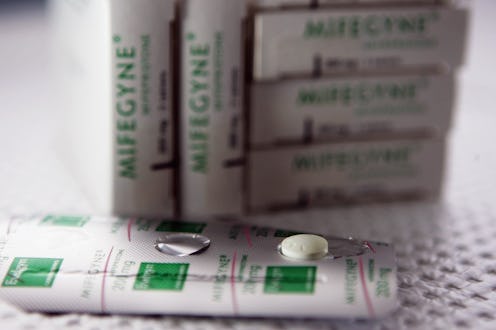News
This Is What Happens When You Cut Abortion Access
A new study is shedding light on the tangible and immediate repercussions of restricting abortion access. For those who would deny the adverse effects of limited access, just ask any of the staggering number of Texas women who tried to self-induce abortions, and they'll be sure to explain to you why abortion access matters. The study, which was conducted in response to Texas' increasingly strict abortion measures, found that anywhere between 100,000 to 240,000 women aged 18-49 had attempted to perform an abortion at home.
The survey, which was conducted by the Texas Policy Evaluation Project (TxPEP) out of the University of Texas, was designed to prove that the increasing numbers of self-induced abortions within the state are directly related to recent legislative efforts to limit access. While conducting the study, TxPEP surveyors asked women if they or their best friend had ever attempted to self-induce an abortion. Based on the response, TxPEP estimates that at least 1.7 percent of the state's population of reproductive age had attempted to self abort. At most, 4.1 percent had attempted an at-home abortion.
The study shows that the methods used varied. Some women tried herbal mixtures, and others obtained abortion medication from pharmacies in nearby Mexico. But others attempted to induce abortion through blunt force to their abdomen, or the use of drugs and alcohol.
Although the methods varied, the reasons were rather similar. Women who indicated they had self-induced cited lack of funds to travel or procure a medical procedure, had a self-induction recommended by a friend, had a local clinic close, or wanted to avoid the stigma of going to a clinic. According to TxPEP, almost all of the women who provided reasons cited money as a factor, however.
It's no surprise that women reported difficulty getting to a clinic or licensed location, however. Due to HB2, an incredibly restrictive bill passed in 2013, the number of abortion providers in the state has dwindled from 41 to 18 in just two years. And some of the most restrictive parts of the bill haven't even gone into effect yet. Several of the measures, one of which requires all abortion doctors to have admitting rights at a nearby hospital, are so controversial that they have been stayed by the Supreme Court. On Friday, the Supreme Court voted to hear a case involving these measures. If they vote it down, it will signal a substantial re-dedication to Roe v. Wade. But if the court votes in favor of it, the number of Texas clinics will lower to 10.
This means that abortion procedures will become even more difficult to acquire, which could lead to further attempts at self-induction. According to the World Health Organization, self-induced and unsafe abortion procedures are most prevalent in the developing world. In a nation with medical advances like we have, methods like these should never be necessary. These at-home procedures are risky for a multitude of reasons, the largest of which is that they aren't carried out by a licensed and trained physician or nurse. Women experiencing adverse reactions don't know what's considered normal or dangerous, and those who don't experience successful inductions may turn to even more drastic measures, or illegal providers.
This study shows what many pro-choice advocates have been saying for decades: limiting abortion access does not stop abortions. These procedures will happen, one way or another. But taking away a safe, monitored alternative only puts women at increased health risks. The number of Texas women willing to go to these means may seem shocking, but depending on how the Supreme Court rules this summer, the number may only go up.
